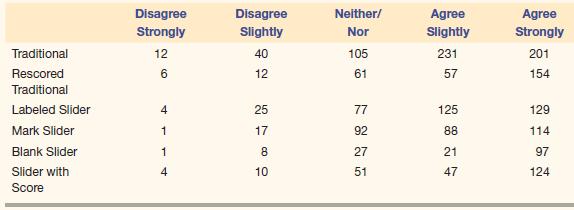Survey Sampling International ran a series of surveys designed to examine the differences between the performances of
Question:
Survey Sampling International ran a series of surveys designed to examine the differences between the performances of a “standard” 5-point Likert scale and a Flashbased slider scale. The two scales were assessed based on data collected, engagement, and respondent satisfaction with the instrument.
The experiment focused on two key ratings issues: equivalency of ratings and the spaces between ratings. In setting up the experiment, respondents were given a traditional Likert scale containing four statements and were asked at the end to rate how well they felt the instrument allowed them to express their true opinions. Respondents were then given a second scale on which they were allowed to rescore previous items on a scale up to 5 points in the direction of any adjacent ranks. While respondents generally expressed satisfaction with the accuracy of the traditional scale, a substantial portion chose to rerate, especially those posting ratings of agree/disagree slightly (as much as 75 percent). On the whole, the results indicated conclusively that the instrument did not offer a fine enough range of responses to precisely reflect respondents’ opinions. In addition, items ranked the same could not be assumed to indicate equivalency of respondent opinions.
In the next stage of the experiment, respondents were asked to rate the statements again using a series of slider scales. Each of the four sliders was text anchored at the end and did not include any visual illustrative elements. The first slider offered the traditional labels; the second kept the hash marks but removed the text; the third removed the marks; and the fourth added a numerical score between 1 and 5 to indicate the position of the slider. The following table offers an example of responses for all six ranking instruments. Responses were for this statement: The highest standards of morals and ethics is [sic] the most important thing in life.
Data distributions varied noticeably across the different designs, indicating that design did matter with regard to how respondents answered. In applying averages and mean scores, however, the data generally seemed to align across the scale designs. The clear takeaway was that the slider scales generally offered greater granularity in terms of response options. That granularity was reflected in respondent attitudes as, overall, respondents using slider scales reported higher satisfaction levels regardless of the slider design.

Questions
1. Using the following scale, assess the following statement:
The assessment of the Likert scale in comparison to the slider scale is accurate.
2. Now given the opportunity, would you place your answer somewhere in between its current position and a position adjacent to it? Why or why not?
3. In answering the previous questions, do you think you have been able to accurately express your opinions regarding the given statement? Explain.
Step by Step Answer:






